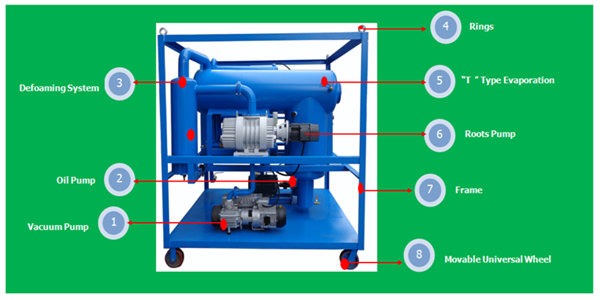Efficient Transformer Oil Recovery: Restoring Oil Quality and Sustainability
Efficient Transformer Oil Recovery: Restoring Oil Quality and Sustainability
Blog Article
Why Dielectric Transformer Oil Issues: Trick Attributes and Maintenance Tips
The significance of dielectric transformer oil expands past mere capability, playing an essential role in both the insulation and air conditioning of electrical transformers. Its unique properties, such as high dielectric strength and chemical security, contribute to functional effectiveness and safety and security. Nevertheless, the maintenance of these oils is just as important to avoid issues that might compromise transformer efficiency. Comprehending the key attributes and best methods for maintenance is vital for ensuring durability and integrity. As we check out these aspects further, the effects for transformer wellness and functional performance become significantly apparent.
Significance of Dielectric Transformer Oil
Dielectric transformer oil plays a vital duty in the efficient operation of electrical transformers, as it is continually used as both an insulator and a coolant. Its insulating residential properties protect against electric discharges and arcing, which are critical to maintaining the integrity of transformer components. By properly separating conductive components, dielectric oil boosts the safety and security and integrity of the transformer, thereby expanding its functional life-span.
In enhancement to its shielding abilities, dielectric transformer oil works as a coolant, soaking up and dissipating warmth created throughout the electrical change process. This thermal management is vital to prevent overheating, which can result in equipment failure and pricey downtime. The oil flows within the transformer, effectively transferring heat far from important locations, therefore guaranteeing optimal efficiency.
In addition, the chemical stability of dielectric oil is important for minimizing the oxidation and destruction that can happen over time (used transformer oil). Routine monitoring of its residential or commercial properties, such as dampness material and acidity, is crucial for preserving its effectiveness. On the whole, the importance of dielectric transformer oil can not be overemphasized, as it is essential to the safe, effective, and long-term procedure of electrical transformers
Secret Qualities of Dielectric Oil
The performance of dielectric transformer oil is mostly figured out by its essential features, which include high dielectric toughness, thermal conductivity, and chemical stability. High dielectric stamina is essential as it permits the oil to withstand considerable voltage levels without damaging down, consequently stopping electrical arcing and ensuring risk-free procedure of the transformer. This characteristic is essential for keeping the dependability of electric systems.
Thermal conductivity is another necessary feature of dielectric oil. It assists in reliable heat dissipation from transformer elements, decreasing the risk of overheating and extending the life-span of the equipment (waste transformer oil). Effective thermal management is important in keeping optimal operating temperatures, which directly influences efficiency
Chemical stability is just as essential, as it ensures that the oil does not deteriorate or respond detrimentally with products within the transformer in time. This stability aids keep the oil's protecting residential or commercial properties and avoids the development of unsafe sludge or deposits that can impair performance.
In addition, reduced viscosity at running temperatures permits far better flow within the transformer, improving both cooling and insulation. Together, these vital characteristics guarantee that dielectric transformer oil performs effectively, supporting the general efficiency and reliability of electric systems.
Benefits of Using Dielectric Oil

Additionally, dielectric oil serves as an effective coolant, dissipating warmth created throughout transformer operation. This temperature level guideline is important for stopping getting too hot, which can cause tools failing or reduced life expectancy. The oil's thermal homes add to optimum operational conditions, making it possible for transformers to function at their ideal.
Another considerable benefit is the oil's chemical stability and resistance to oxidation. These properties minimize the development of sludge and various other destruction byproducts, thereby minimizing maintenance needs and expanding the intervals between oil changes. Dielectric oil supplies exceptional wetness absorption capabilities, which safeguard the transformer from the damaging impacts of water ingress.
Maintenance Finest Practices

Additionally, maintaining the transformer's temperature level within defined limitations is important. Raised temperatures can speed up oil destruction, detrimentally affecting its dielectric buildings. Applying a temperature level tracking system can assist in preserving ideal conditions.
Furthermore, ensuring proper air flow and cooling of the transformer unit reduces the threat of overheating. It is additionally essential to maintain the transformer devoid of particles and pollutants that may jeopardize its performance.
Carrying out periodic aesthetic examinations for leakages, rust, or signs of endure gaskets and seals is another best practice. Any type of pop over to this site irregularities must be attended to immediately to stop oil contamination and preserve system integrity.
Last but not least, establishing a maintenance schedule that includes oil substitute or treatment can improve the lifespan of dielectric oil, ensuring it remains to do successfully. By taking on these upkeep best techniques, drivers can enhance transformer efficiency and decrease unplanned downtime.
Common Issues and Solutions
Transformers making use of dielectric oil can come across several usual issues that might impact their efficiency and dependability. One famous concern is the deterioration of the oil due to thermal tension, which can cause lowered dielectric stamina and boosted threat of arcing. Routine surveillance of the oil's temperature and applying cooling remedies can minimize this issue.
Another worry is moisture access, which can jeopardize the protecting residential or commercial properties of the Continue oil. This can be resolved through routine testing for water material and using desiccants or vacuum cleaner dehydration procedures to eliminate moisture.
In addition, the development of sludge as a result of oxidation can obstruct regular operation. This can be fixed by regular oil purification and substitute when required, making sure optimal fluid cleanliness.

Verdict
In final thought, dielectric transformer oil plays an essential function in ensuring the effective procedure and safety of electrical transformers. The significance of dielectric transformer oil can not be overemphasized in the world of electrical framework dependability.
The relevance of dielectric transformer oil extends beyond simple capability, playing a pivotal function in both the insulation and cooling of electrical transformers.Dielectric transformer oil plays a vital role in the efficient procedure of electric transformers, as it is consistently used as both a coolant and an insulator. Generally, the relevance of dielectric transformer oil can not be overemphasized, as it is fundamental to the safe, effective, and long-lasting procedure of electrical transformers.
The efficiency of dielectric transformer oil is mostly established by its crucial qualities, which consist of high dielectric toughness, thermal conductivity, and chemical security.In verdict, dielectric transformer oil plays an important function in guaranteeing the effective operation and safety of electrical transformers.
Report this page